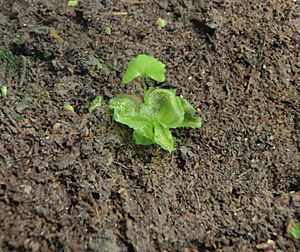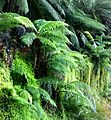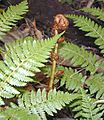Fern facts for kids
Quick facts for kids Ferns (Pteridophyta)Temporal range: Mid Devonian – Recent
|
|
|---|---|
 |
|
| Polystichum setiferum showing unrolling young frond | |
| Scientific classification | |
| Kingdom: | |
| Division: |
Pteridophyta
|
| Classes | |
|
Psilotopsida |
|
Ferns are a special group of plants, with about 10,000 different kinds alive today. They belong to a plant group called Pteridophyta. Unlike mosses, ferns have special tubes inside them called xylem and phloem. These tubes help move water and food around the plant, making ferns vascular plants.
Most ferns you see in gardens or forests are part of a group called Leptosporangiata. Horsetails are another type of fern. They were super important long ago during the Carboniferous period. Back then, some horsetails grew as tall as 30 meters! Today, only one type of horsetail still exists.
Ferns have roots, stems, and leaves. Their stems can grow above ground like runners, called stolons. Or they can grow underground, which are called rhizomes. Fern leaves are usually green and large. They often have tiny spores on their underside. Some ferns can grow very big in wet places. They can live in more places than mosses, but not as many as flowering plants.
Millions of years ago, during the Carboniferous period (about 350 million years ago), ferns grew almost everywhere on land. There were huge forests made of ferns and mosses. These forests were home to giant insects. Today, most ferns are not as large as their ancient relatives.
Contents
Where Do Ferns Live? (Ecology)
You might imagine ferns only growing in cool, shady forests. But ferns actually live in many different places! You can find them high up in mountains or on dry desert rocks. Some even grow in water or open fields. Ferns are often good at living in places where other plants, like flowering plants, struggle.
Some ferns can even become weeds. For example, the bracken fern grows widely in the Scottish highlands. The mosquito fern (Azolla) can cover tropical lakes. Both of these ferns spread very quickly.
Ferns are found in four main types of places:
- Moist, shady forests.
- Cracks in rock faces, especially if they are out of the direct sun.
- Wetlands with acidic soil, like bogs and swamps.
- Tropical trees, where many ferns grow as epiphytes. This means they grow on other plants but don't take food from them. About a quarter to a third of all fern species are epiphytes!
Epiphytic ferns are home to many different small creatures. For example, bird's-nest ferns alone might hold half of all the tiny animals in a hectare of rainforest canopy.
Many ferns need help from tiny fungi called mycorrhizal fungi to grow. Also, many ferns only grow in certain soil conditions. For instance, the climbing fern (Lygodium palmatum) needs very acidic soil. But the bulblet bladder fern (Cystopteris bulbifera) only grows on limestone.
The spores of ferns are full of fats, proteins, and calories. Because of this, some animals eat them. The European woodmouse eats the spores of Culcita macrocarpa. The bullfinch and the New Zealand lesser short-tailed bat also enjoy eating fern spores.
How Ferns Reproduce (Life Cycle)

Ferns are vascular plants, meaning they have tubes for water and food. They have true leaves, which are often shaped like feathers. Ferns are different from seed plants (like trees and flowering plants) because they do not have flowers or seeds. Instead, they reproduce using spores.
Like all land plants, ferns have a special life cycle called alternation of generations. This means their life has two main stages:
- The sporophyte stage, which has two sets of chromosomes (diploid). This is the fern plant you usually see.
- The gametophyte stage, which has one set of chromosomes (haploid). This stage is a tiny, free-living plant.
Here's how a typical fern's life cycle works:
- The sporophyte (the main fern plant) makes tiny, haploid spores. It does this through a process called meiosis, which cuts the number of chromosomes in half.
- A spore then grows into a small, haploid gametophyte. This happens through mitosis, a process where cells divide and keep the same number of chromosomes. The gametophyte is usually a flat, green plant called a prothallus.
- The gametophyte then makes gametes (sperm and eggs) using mitosis. Often, both sperm and eggs are made on the same prothallus.
- A sperm, which can swim, fertilizes an egg. The egg stays attached to the prothallus.
- The fertilized egg is now a diploid zygote. This zygote grows into a new diploid sporophyte (the typical fern plant) through mitosis.
Gallery
-
Tree fern Spores San Diego
Images for kids
-
Ferns at the Royal Melbourne Botanical Gardens
-
Tree ferns, probably Dicksonia antarctica, growing in Nunniong, Australia
-
Sporophylls of Acrostichum aureum
-
Close-up of a monarch fern sorus, showing its sporangium
-
Blätter des Manns Walfarn. by Alois Auer, Vienna: Imperial Printing Office, 1853
-
Fern bed under a forest canopy in woods near Franklin, Virginia
-
Silver fern or Alsophila dealbata, endemic to New Zealand
-
Hymenophyllum nephrophyllum, the kidney fern
-
Tree fern, probably Dicksonia antarctica
-
"Filicinae" from Ernst Haeckel's Kunstformen der Natur, 1904
-
Fern leaf, probably Lomaria nuda
-
Nature prints in The Ferns of Great Britain and Ireland used fronds to produce the plates
See also
 In Spanish: Helechos para niños
In Spanish: Helechos para niños





























